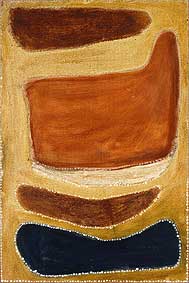|
|

|
Yiribana Aboriginal & Torres Strait Islander Gallery

|
The current exhibition in the Yiribana Aboriginal and Torres Strait Islander Gallery at the Art Gallery of New South Wales, continues the series of exhibitions drawn from the permanent collection of Aboriginal and Torres Strait Islander Art. The exhibitions began with a material thing: Objects from the Collection, followed by Another Country featuring works on paper, and Ochre: Bark Paintings from the Collection. Now a selection of major paintings, featuring the work of some of the most influential Aboriginal artists of the last two decades, will be on display until Sunday 2 September 2001.
Many of the works on display are new additions to the Art Gallery�s collection and include a significant recent acquisition from the private collection of Mary Macha. Untitled (Two Men Dreaming) c1986 by the late Rover Thomas is displayed with a selection of other works by this renowned artist from the mid-1980s that capture the essence of the country around Warmun (Turkey Creek) in the northeast Kimberley. Paintings by contemporary senior Gija artists Paddy Bedford and Goody Barret also depict the country around Warmun and stories specific to particular locations in the region.
Two paintings by Rusty Peters and the late Timmy Timms are from a series of paintings depicting sites where massacres of Gija people took place in the early part of the twentieth century. Hunting Grounds 1993 by fellow West Australian artist Pantjiti Mary McLean celebrates Ngaatjatarra bush life before contact with Europeans. Its vibrant figuration contrasts with the Gija artists� sparse renditions of country and sometimes tragic subject matter.
Artists Alice Nampitjinpa, Narputta Nangala, Marlee Napurrula, Long Tom Tjapanangka and his wife Mitjili Napurrula are from the Ikuntji Women�s Centre at Haasts Bluff. An etching by Alice Nampitjinpa and suite of paintings on both canvas and paper by the other artists show the development of this group over the last ten years. In this section one can glimpse the Indigenous kinship system that operates between desert communities with the juxtaposition of Mitjili Napurrula�s painting Spears at Uwalki 1993 and Straightening the Spears 2000 by her brother Turkey Tolson Tjupurrula. Both are versions of the same story and were inherited from their father.
Fellow founding Papunya Tula artists Mick Namarari Tjapaltjarri and Timmy Payungka Tjapanangka, both of whom have passed away, are represented by some of their last works that demonstrate the ongoing dynamism of contemporary desert painting since the movement began in the early 1970s. Similarly, the work of company chairperson, Joseph Jurra Tjapaltjarri, reveals the seemingly infinite capacity for renewal in Papunya Tula painting.
The paintings by the late Anmatyerre artist, Emily Kame Kngwarreye, of the neighbouring desert community, Utopia, are based on awelye � women�s ceremony and associated activities. This painting relates to the paintings and etchings by Kutuwalumi Purawarrumpatu (Kitty Kantilla) and Taracarijimo (Freda Warlapinni) two senior women artists from Milikapiti on Melville Island, who base their work on Tiwi ceremonial body designs.
A different vision is displayed in paintings by Brisbane based artist Gordon Bennett who visually deconstructs Australia�s 19th century colonial history, often by appropriating the icons of Western art as seen in the Pollock-like grid of Myth of the Western Man (White Man�s Burden) 1992. Ngarrindjeri artist Ian Abdulla�s paintings document the history of Aboriginal people in the Riverland region, and aided by the use of text as part of the work, perform a very personal function in reclaiming the more recent past.
Two major paintings by Ginger Riley Munduwalawala depict his mother�s country of Limmen Bight River and a large land formation called the �Ruined City� � a recent development in the artist�s oeuvre. In July 2000, Ginger Riley successfully demonstrated his Native Title rights over his country as a traditional owner and Djungkayi (caretaker). These paintings are not only vivid evocations of the land of Riley�s ancestors; they unequivocally assert his connection to country as a Mara elder.
This exhibition demonstrates it is through the extraordinary achievements of Indigenous artists over the past few decades that the wider community have come to fully appreciate the antiquity, complexity and ongoing significance of Aboriginal and Torres Strait Islander culture.
The Yiribana Aboriginal and Torres Strait Islander Gallery at the Art Gallery of New South Wales is sponsored by Qantas
|
| On view: | Yiribana Aboriginal & Torres Strait Islander Gallery
at the Art Gallery of New South Wales
Art Gallery Road
The Domain, Sydney | | Telephone: | (02) 9225 1744 or recorded information
(02) 9225 1790
| | Hours: | 10am to 5pm 7 days a week | | Admission: | Free of Charge | | Media Information and Interviews: | Jan Batten, Press Office
telephone 61 2 9233 1213
email janb@ag.nsw.gov.au | Rover Thomas
Untitled (Two Men Dreaming) c.1986
natural pigments on canvas board, 91 x 61cm
collection Art Gallery of New South Wales
|
|
|